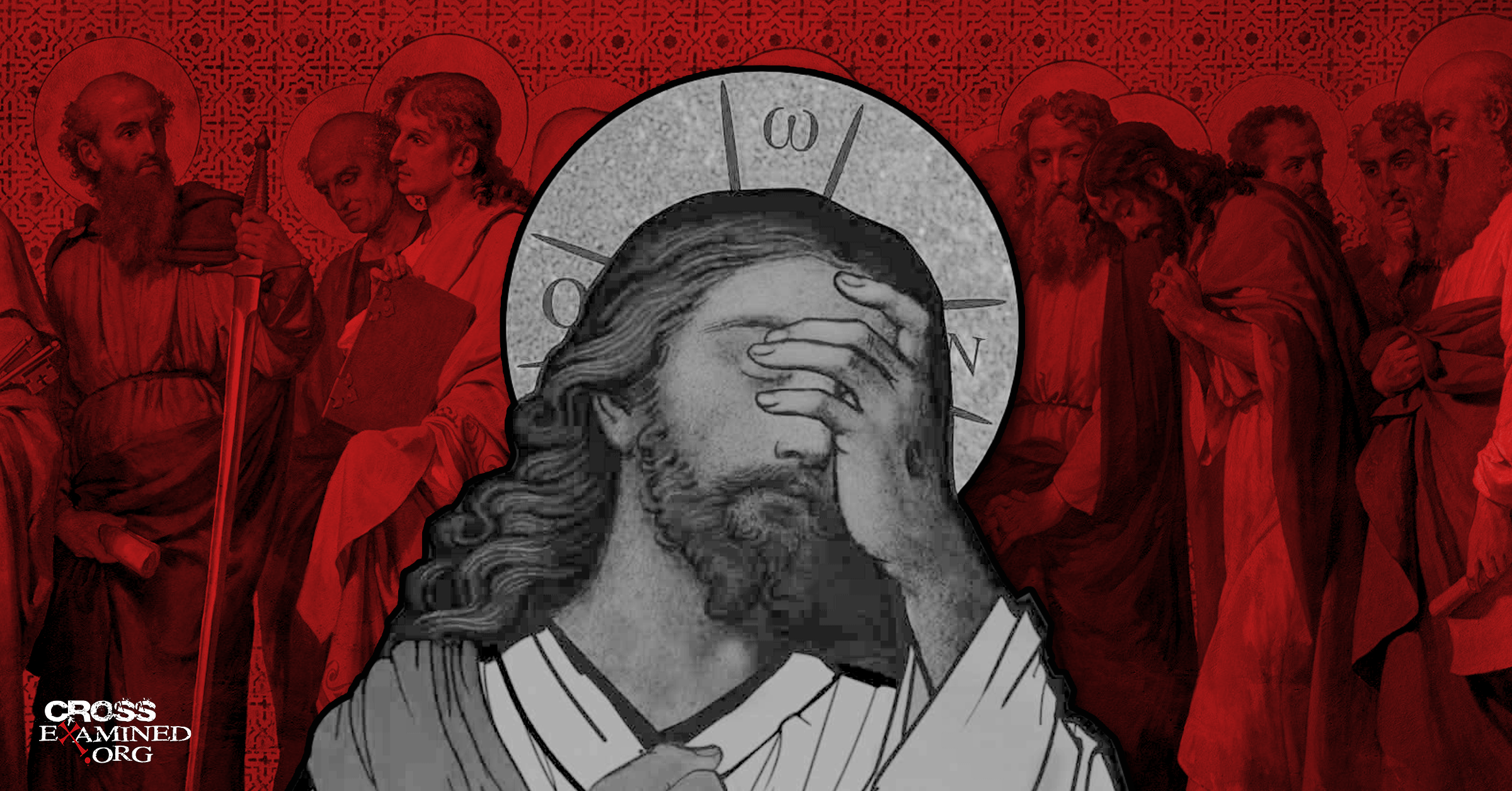In my experience, the typical discussion of “spiritual warfare” centers on the stuff of the old Frank Peretti novels like This Present Darkness or Piercing the Darkness. It’s all about gargoyle-looking demons snarling on our shoulders, power plays, and satanic influences. But the whole “devil made me do it” thing has always seemed a little over-the-top to me. For that reason, it’s a subject I have mostly ignored. It certainly never seemed to have much to do with the things I like to talk about here — arguments and evidence. But it turns out there is a direct connection between apologetics and spiritual warfare. And all of us need to understand what it is.
The Balanced View
As usual, C. S. Lewis encourages us to consider a more reasonable view of the spiritual warfare than the one we usually hear:
“There are two equal and opposite errors into which our race can fall about the devils. One is to disbelieve in their existence. The other is to believe, and to feel an excessive and unhealthy interest in them.”
~ C. S. Lewis, The Screwtape Letters
Balance is always good. And if you want an introduction to that view of spiritual warfare, there is no more entertaining way to get it than reading C. S. Lewis,’ The Screwtape Letters. The gist of the book is that Screwtape is a senior demon who is training his understudy, Wormwood, about how to best mess with humans. The book is a record of their dialogue. It’s a training manual for spiritual warfare — from the bad guys’ point-of-view.
Lewis said it was the most difficult book he ever wrote because it forced him to think backwards. God is the “enemy.” Promoting evil is Screwtape’s mission.
I’ve always enjoyed Lewis’ unique approach. But more recently, I’ve come to see spiritual warfare in an even more pragmatic way.
Close Encounters of a Different Kind
In lesson two of his 8-part course, The Bible Fast Forward, Greg Koukl makes a fantastic insight about this. He points out that much of the emphasis in the church on spiritual warfare has been on engaging in power encounters. We talk about binding, loosing, and casting out demons with specific kinds of prayers. Much like Frank Peretti, we focus on methods we can use to counteract the evil enterprises of the enemy.
But, Koukl says, Scripture suggests something different. His point is that the essential character of spiritual warfare is not about power encounters with the devil. It is about truth encounters. It’s about opposing lies and deception.
Paul’s Take on Warfare
In 2nd Corinthians 10:3-5, Paul addresses the issue this way:
“For though we live in the world, we do not wage war as the world does. The weapons we fight with are not the weapons of the world. On the contrary, they have divine power to demolish strongholds. We demolish arguments and every pretension that sets itself up against the knowledge of God, and we take captive every thought to make it obedient to Christ.”
Then, in Ephesians 6, the most famously quoted Bible passage on the subject, Paul goes on to describe the fight:
“For our struggle is not against flesh and blood, but against the rulers, against the authorities, against the powers of this dark world and against the spiritual forces of evil in the heavenly realms.”
But in the plea that follows, Paul doesn’t tell the Ephesians to pray against the rulers, authorities, and powers. Rather, he tells them to pray for perseverance. He asks them to pray that he and those around him might speak the truth fearlessly.
Do you see the difference?
The Battlefield of Ideas
The weapons of spiritual warfare are thoughts. The battlefield is in our minds. And that means that an apologist — a defender of the faith — lives at the forward edge of the battle area. The battlefield is not just a place to make arguments about topics like the existence of God, the design of the universe, or the reliability of Scripture.
It’s a place to fight for the essence of truth itself.
Think about it. Normal, rationally thinking human beings could never come up with some of the ideas our culture accepts without question. Those who argue in favor of corruptions of human sexuality — things like same-sex “marriage” or gender fluidity — aren’t just arguing about the moral nature of their conduct. Reasonable people could debate that kind of thing. Instead, they are denying biological reality itself. And, as Carl Trueman puts it in his book, The Rise & Triumph of the Modern Self, “many in our society [insist that] to deny it or question it in some way is to reveal oneself as stupid, immoral, or subject to yet another irrational phobia.”*
In other words, the culture holds in contempt anyone who claims to see reality for what it actually is. We have arrived at the place George Orwell warned about 100 years ago, “In a time of deceit, telling the truth is a revolutionary act.”
Not Just A Cultural Trend
Human sexuality is at the epicenter of the cultural battles that are raging around the topics of truth and reality. But it’s not the only issue. Our society has also accepted without argument the idea that science will solve all our problems. This philosophical view is called “Scientism.” And it’s based on the notion that science and faith are in a perpetual state of war. But, as I’ve discussed elsewhere, that is a lie. Science and theology are complementary ways knowing things about the world. They are mutually reinforcing allies in the ongoing battle for the truth.
Likewise, those who foment hatred in our society do so by disingenuously politicizing the news. They do it using incidents of racism, oppression, inequity, and inclusion. Surely, we can find blatant examples of abuse with each of these. No thinking person can deny it. But that does not mean our entire society can be reduced to them. Generalizations are never a good idea. You don’t define the whole by the abuses of outliers.
But the really troubling thing about all these trends is that they are not just cultural phenomena. They are also infiltrating our churches under the banner of “Progressive Christianity” and “social justice.” I guess we should expect the world to turn things inside out and upside down. But when the church goes along with it, I don’t see any other way to explain it except as the consequence of spiritual warfare.
The “Social Justice” Deception
Back to C. S. Lewis. In one of his training sessions with Wormwood, the indomitable Screwtape hits on the topic of how to remove spirituality from the Christian’s life. His method may sound familiar:
“We want men to treat Christianity as a means; preferably, of course, as a means to their own advancement, but, failing that, as a means to anything – even to social justice. The thing to do is to get a man first to value social justice as a thing which the enemy demands, and then work him on to the stage at which he values Christianity because it may produce social justice … it is quite easy to coax humans around this little corner. Only today I have found a passage in a Christian writer where he recommends his own version of Christianity on the ground that ‘only such a faith can outlast the death of old cultures and the birth of new civilizations.’ … You see the little rift? ‘Believe this, not because it is true, but for some other reason.’ That’s the game …” (emphases mine)
Remember, Lewis wrote those words in 1942. It turns out the battle for our minds hasn’t changed much over the years. Screwtape’s minions have been wildly successful in their mission to deceive the world. Our challenges as defenders of the faith are complicated but they’re not new. When it comes right down to it, they’re as old as the Garden of Eden.
A Reason For Hope
When you see spiritual warfare this way you realize it never stops. The battle of ideas will continue far into the future. We can’t escape the battle. But we can embrace a battle plan that refuses to surrender. As Rod Dreher put it in his fantastic book, Live Not By Lies: A Manual For Christian Dissidents,
“You have to live in a world of lies, but it’s your choice as to whether that world lives in you.”
~ Rod Dreher
If you watch the news, this can all become very discouraging. But as an apologist, we don’t have time to be discouraged. Our charge is not just to give answers. It is to “always be prepared to give an answer to everyone who asks you to give a reason for the hope that you have…”
Hope.
In The Everlasting Man, G. K. Chesterton surveys the many forces that have threatened to destroy Christianity over the last 2000 years. “Time and again,” said Chesterton, “the Faith has to all appearances gone to the dogs. But each time, it was the dog that died.”
Our faith and our church have been under attack since the beginning of time. But the Bible and history are littered with examples of the saints who persevered in the face of both physical and spiritual warfare. Our time is unique in many ways. But from an eternal perspective the mission is still the same. Lies are still the enemy. And truth is still unchanging.
And that is the reason we have hope.
Recommended resources related to the topic:
I Don’t Have Enough Faith to Be an Atheist (Paperback), and (Sermon) by Norman Geisler and Frank Turek
Stealing From God by Dr. Frank Turek (Book, 10-Part DVD Set, STUDENT Study Guide, TEACHER Study Guide)
Tactics: A Game Plan for Discussing Your Christian Convictions by Greg Koukl (Book)
Defending the Faith on Campus by Frank Turek (DVD Set, mp4 Download set, and Complete Package)
So the Next Generation will Know by J. Warner Wallace (Book and Participant’s Guide)
Fearless Faith by Mike Adams, Frank Turek, and J. Warner Wallace (Complete DVD Series)
__________________________________________________________________________________________________________________________________________________
Bob Perry is a Christian apologetics writer, teacher, and speaker who blogs about Christianity and the culture at truehorizon.org. He is a Contributing Writer for the Christian Research Journal and has also been published in Touchstone, and Salvo. Bob is a professional aviator with 37 years of military and commercial flying experience. He has a B.S., Aerospace Engineering from the U. S. Naval Academy, and an M.A., Christian Apologetics from Biola University. He has been married to his high school sweetheart since 1985. They have five grown sons.
Original Blog Source: https://cutt.ly/wW6E98x










